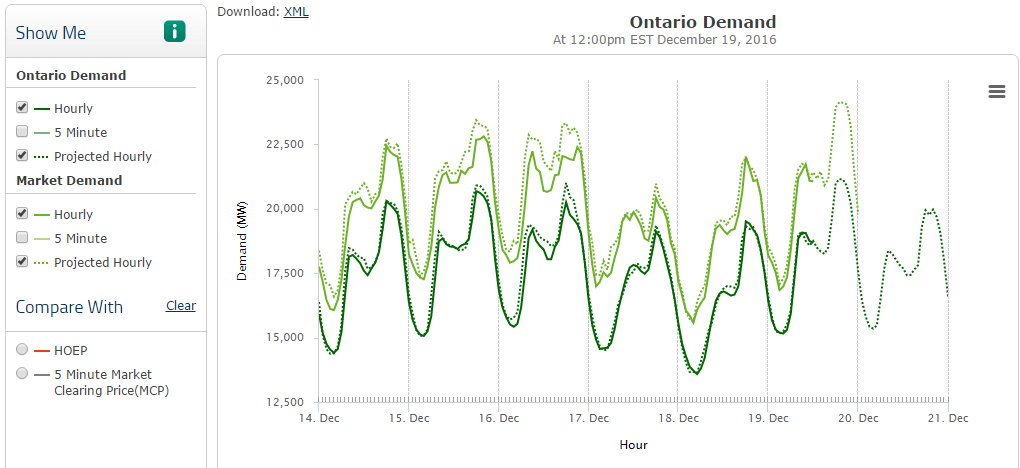In order to decide which GHG reduction strategies to pursue, TAF looks at the quantity of reductions each approach has the potential to achieve. Central to these calculations are the emission factors – i.e. how much carbon is associated with each unit of energy consumed or saved. The challenge is that electricity emission factors can be very different depending on how they are calculated. In this blog we’re going to take a look at electricity emissions factors, how they’re calculated and the resulting impact on our understanding of the potential GHG reductions of electricity conservation measures.
Not all conservation measures are equal.
Currently, the most common way to calculate emissions from electricity reduction is to use an average electricity emissions factor. An average electricity emissions factor is calculated by dividing the total quantity of emissions generated by the total quantity of electricity generated over the same amount of time (usually on an annual basis). However, using the average factor doesn’t consider that differences in generation fuels, their relevant emissions, time of generation, and time of consumption. By extension, then, conservation activities undertaken at times when higher-carbon fuels are in use drives more GHG reduction than those undertaken when the system relies more on low-carbon generation. Figure 1 shows how electricity demand changes with time in Ontario. An annual average electricity emissions factor doesn’t capture this complexity in the system and might result in underestimating emissions from electricity use or conservation.

Figure 1 – Ontario’s Demand and Projected Demand for a Week in December (via IESO)
Marginal Emissions Factors
One way to improve electricity emissions estimates is by using a marginal electricity emissions factor which attempts to consider the different types of fuels used, when they are used and in which order they are supplied to the grid. Marginal electricity emissions factors attempt to account for ‘the last’ source of electricity produced to meet the demand at any given time. For example, measures that conserve energy at times when natural gas-fired energy is being used to handle peak loads (such as air conditioners which are on during the hottest hours of the day) will result in more carbon reductions than measures achieving reductions when nuclear and hydro-powered baseload is being used (such as streetlights being on overnight). This is why use of marginal electricity emissions factors can produce a more accurate estimate of GHG emissions reductions impacts from specific conservation measures.
Considerations in Using Marginal Emissions Factors
Consideration of the marginal factors might seem to imply that increasing electricity use overall – for example by increasing electric vehicle use – would not be a good GHG reduction measure. However, even when higher carbon electricity sources are used, they still have lower GHG impact than gasoline and diesel fuels.
The purpose of using marginal factors is to more accurately reflect the actual emissions reductions potential from different electricity conservation approaches, and from producing renewable electricity. A marginal factor also reinforces the benefits of shifting electricity demand in ways that minimizes the need for higher-carbon emissions electricity sources such as natural gas plants.
TAF’s approach to using marginal emissions factors
For estimating the emissions reductions from electricity conservation or renewables projects, TAF recommends using a marginal electricity emissions factor of 0.00015 tCO2eq/kWh which reflects analysis of 2015 IESO data. This factor may be updated in the future with new data and methodologies. For electricity consumption, TAF recommends using Canada’s 2016 National Inventory Report’s factor for Ontario, 0.00005 tCO2eq/kWh. As you can see, the marginal factor for Ontario’s electricity using this calculation approach is three times higher than the average electricity emissions factor. This has a dramatic effect on the emissions reductions calculated, as shown below in Table 1.

Table 1 – Ontario Electricity Emissions Factors Details
Some examples of measures where a marginal electricity emissions factor could be applied include:
- An LED lighting retrofit;
- Energy storage (a battery or an electric vehicle which can be charged overnight and then used to supply electricity during peak demand);
- Shifting use of appliances such as vacuums, washing machines, and dishwashers to off peak times;
- Installing solar PV panels; and
- Using programmable thermostats to reduce air conditioning or electrical heating during peak times.
When calculating emissions and emissions reductions we should strive to provide accurate estimates. In the past, use of average emissions factors to calculate the GHG impacts of electricity conservation has been the common practice, potentially leading to underestimations of the impacts of some measures. By using a marginal electricity emissions factor to estimate emissions savings from electricity reduction strategies, we are able to better reflect the complexities of electricity generation and consumption. This is especially important in electricity systems where peak demand electricity is supplied by fuels with more emissions than baseload electricity sources.
This is the third article in our blog series: ABCs of GHGs.

